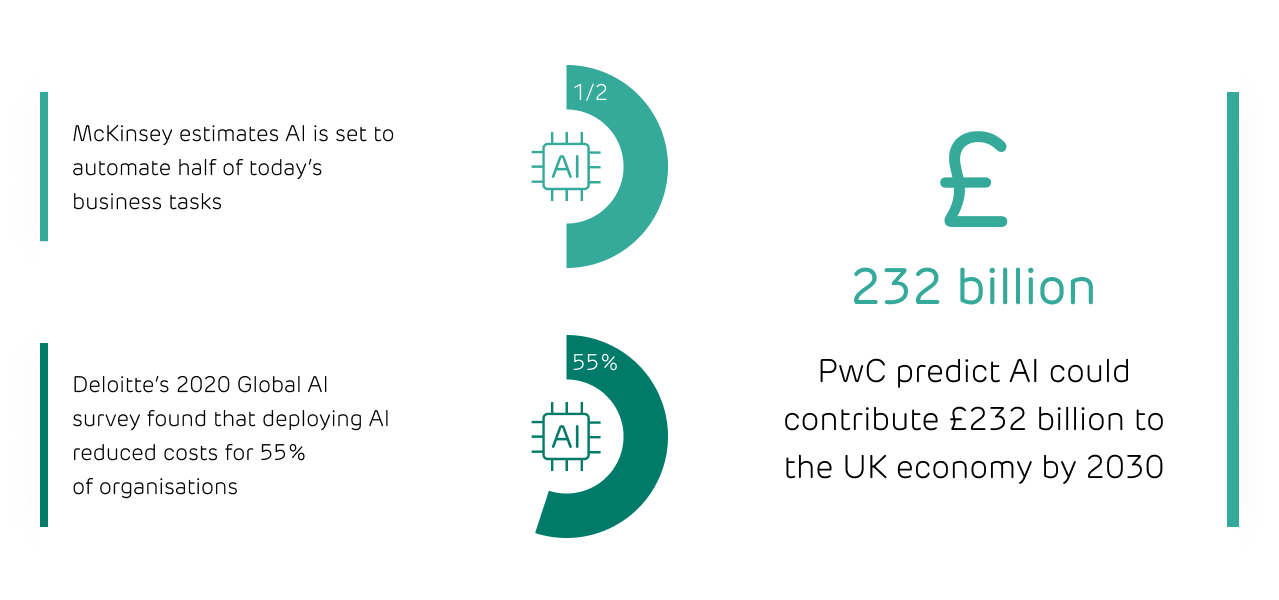AI is changing everything about how we work. But how is it going to change the workplace itself - and our approach to office design?
The influence of AI is already palpable in modern offices. It’s beginning to control the physical environment and the daily rhythms of work.
And the predictions for its effect on productivity continue to amaze:

With the rise of agentic AI - software that can plan and act autonomously - we’re only just beginning to understand the nature of the transformation ahead.
Agentic AI is reshaping the world of work
Agentic AI refers to software systems that don’t just assist with tasks but can reason, decide, and action entire decision chains independently. They are not just generative AI tools - they are systems capable of executing complex tasks from end to end.
As the Harvard Business Review explains:
“In 2023, an AI bot could support call centre representatives by synthesising and summarising large volumes of data... In 2025, an AI agent will be able to converse with a customer and plan the actions it will take afterwards - processing a payment, checking for fraud, and completing a shipping action.”
This leap goes far beyond partial automation.
From accounts departments to customer support teams, it seems, the functions of many office based teams are about to swept away.
But for many thinkers, this kind of automation is not about displacement. it's about delegating workflows; freeing human workers to focus on higher-value, strategic and creative tasks.
So, will AI take our jobs?
 Source: Goldman Sachs
Source: Goldman Sachs
However, the World Economic Forum (WEF) is optimistic that those losses will be offset by the creation of more satisfying, creative roles:

Source: WEF
Welcome to the age of superagency
Where offices once supported routine, process-driven tasks, with AI they’ll become places where humans co-operate with tech in much more exciting ways.
This is what the business thinkers Kevin Roose and Ethan Mollick call ‘superagency’.
“Superagency is what happens when large numbers of people get access to a transformative technology and apply new superpowers to their lives in unrestricted, and inventive ways. Because so many other people have new superpowers too, new capabilities and adaptations cascade through society, endowing every individual with a multitude of second-order benefits.”
Roose & Mollick, Superagency, What Could Possibly Go Right with Our AI Future
In this era of AI-powered superagency:
- Marketers can ideate end design full campaigns in an afternoon.
- Analysts can model, visualise, and simulate in minutes.
- Product managers can prototype and code software —without ever writing a line themselves.
Supporting the age of superagency
Individual workers won’t just be more efficient, AI will empower them to collaborate more freely and effectively to find new solutions to age-old business problems.
- People will need to come together to co-create at speed
- Teams will leverage AI outputs to unlock instant execution across disciplines
- Learning and up-skilling will take centre stage in business hubs
- Human creative drive, not capacity, will become the true constraint
The AI-augmented office: a platform for performance
To support this new world of work, the office is evolving into a performance platform - a dynamic environment designed to unlock human potential through supporting new levels of environmental control, agility, creativity, and collaboration.
A case study - the AI powered environment
In fact, AI tools are already transforming the physical workplace to make for more frictionless and efficient experiences.
Deloitte's purpose-built smart office "The Edge" in Amsterdam showcases an AI-driven office as a performance platform, using its 28,000 sensors to create a hyper-efficient, responsive environment.
At The Edge, employees use an app for personalised hot-desking and to control lighting and climate, while AI dynamically optimises energy use, space, and operations based on real-time data.
This integration of smart automation and personalisation transforms The Edge into a dynamic platform that boosts efficiency and supports flexible, high-performance work.
Designing the office of the future
But here’s a growing challenge to fit out and furnish existing offices, too, to meet the changing demands of an AI driven world.
This article by Steelcase (backed by real-world office occupancy data) shows how traditional office spaces built for pre-hybrid work are quickly becoming dead zones.
It today’s hybrid and hyper-collaborative workstyles—blending focus, teamwork, and digital connection - demand environments that flex as fast as people do. And most offices haven’t kept up.
This article looks at a typical open plan office layouts:

And shows how they could be optimised for the age of superagency:

Plans generated through collaboration with AI, user data, feedback and designer expertise imagine new spaces that can flex more easily with changing occupancy demands.

Adding generative AI to brainstorming and problem-solving sessions will lead to a need for larger digital displays and the integration of analog and digital tools like markerboards and content cameras. And don’t just add video to meeting rooms. Consider furniture design and layout in relationship to the camera, lighting, microphones and acoustics.
🧭 Eight distinct work modes are now accessible within a single office footprint.
🛋️ Lounge and shielded areas offer quiet time for rejuvenation and deep focus.
🔇 Acoustic pods near workstations provide privacy without isolation.
🗂️ Lockers and personalisation zones offer autonomy even in non-assigned seating setups.
🧱 Modular walls like Everwall block distractions and support rapid space reconfiguration.
🖊️ Writable surfaces and pinboards keep ideas visible and help teams resume flow fast.
📺 Tech like the Surface Hub ensures hybrid collaboration is seamless and inclusive.
Thanks to AI, rooms are getting smarter. Zoom’s Intelligent Director taps into multiple cameras and advanced AI to ensure people in medium-to-large meetings are visible to remote attendees, even as they move. And Logitech’s AI-enabled cameras recognize when someone new joins or speaks and reframes the camera to include them. Microphones pick up voices and drown out periphery noise. And one-touch join makes it simple to get a meeting going.Immersive spaces with large screens can maximise virtual connections and work with arrays of content.
Smarter, faster, more informed design
But if the age of AI is demanding different office designs; office designers are using the new technology to bring their ideas to life.
Workplace design consultancies now use AI capabilities to dramatically enhance the early stages of planning.
With these tools, designers can:
- Generate test layouts and spatial configurations using simple prompts.
- Create mood boards and visual concepts in seconds with generative design platforms.
- Analyse occupant feedback and iterate designs based on insights.
- Simulate flow, acoustics, and occupancy patterns before anything is built.
These AI applications make the "what if?" phase of design faster, more visual, and more data-informed - leading to smarter decisions and increased efficiency.
Smarter product discovery and specification
From a procurement point of view, AI is also streamlining the furniture selection and specification process:
- Instantly filtering vast product libraries by sustainability, price, technical skills required, or usage criteria.
- Matching product needs to job roles and workplace types.
- Supporting circular procurement and environmentally responsible sourcing strategies.
So, what’s the role of designers and dealerships in the age of AI?
With the design and analytical capabilities of generative AI - and the administrative power of agentic AI - some business leaders are asking about the continued relevance of design consultancies in this sector.
If AI can be deployed independently by procurement and workplace experience managers to help with furnishing and fit out - will their role be scaled back?
But right now, there are many compelling reasons to engage with dealerships that offer design consultancy, to help you navigate the challenges ahead.
1. AI generates ideas - but humans translate them into real spaces
Generative AI can produce visualisations, moodboards, or floorplans in seconds—but these are based on prompts, not context. Designers bring the deep knowledge of your brand, culture, and constraints needed to translate AI output into a coherent, buildable strategy.
2. Agentic AI supports procurement—but not relationships
Agentic AI can help automate product selection and track lead times or material availability. But it can’t replicate the value of trusted relationships —both with suppliers and within the design team itself. Designers and dealerships bring a level of collaboration, empathy, and responsiveness that AI can’t match.
3. Designers spot what data doesn’t reveal
AI excels at analysing patterns—but it doesn’t walk your space, observe behaviours, or hear what staff are saying or not saying. Designers provide a human layer of insight - reading between the lines to uncover needs, preferences, and usage habits that drive more intuitive design.
4. Workplace design is now a strategic lever—not just a layout
In an era of hybrid working, AI integration, and evolving employee expectations, your workplace is a critical tool for culture, performance, and talent retention. Designers and dealerships help organisations think bigger—advising on strategy, change management, and experience.
5. Implementation still relies on real-world expertise
You can simulate almost anything—but when it comes to actual fit-out, compliance, logistics, and installation, you need experts who understand the practical realities of delivery, coordination, and execution. This is where dealerships are invaluable—not just in planning, but in making it happen.
Editor's note: This post was originally published in 2023 and updated in May 2025 for relevance and accuracy.










